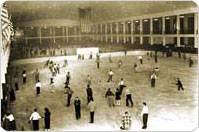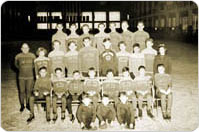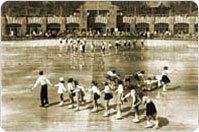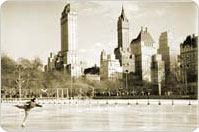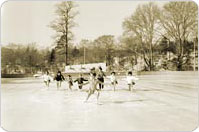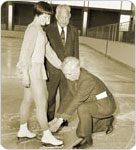The History of Ice Skating in New York City Parks
Find information about NYC's ice skating rinks, their hours, and locations at the Ice Skating webpage.
Early Plans – The Start of Parks' Ice Skating
Our ice skating history begins before specially designed ice skating rinks were built in the 20th century, at a time when skaters used ponds and lakes in parks for recreation.
The Lake in Central Park, labeled on Olmsted and Vaux's original Greensward plan as a "skating pond,' was the most notable case of this use. Before Central Park was completed in the 1870s, this section was opened to ice skaters and quickly became a top attraction. In order to ensure proper skating conditions, the Lake was drained to a level that eased the freezing of ice each year. (The Lake — then as now — was connected to the City's water system.)
Ice Skating Beyond Central Park
Meanwhile, other bodies of water were used for ice skating throughout the park system. In Brooklyn, skating sites existed at McCarren Park, Prospect Park, Sunset Park, and Commodore Barry Park.
In fact, ice skating was so popular in the 19th century that a tradition of "raising the red ball" on Brooklyn streetcars was created to indicate favorable skating conditions at Prospect Park.
The Brooklyn Parks Department annual report of 1920 notes that in Prospect Park, the Boat House was converted to a Skate House which also offered coffee and snacks. The same report indicates ice skates could be rented for 25 cents an hour.
Skating spots likely existed at Willowbrook Park on Staten Island during this time period as well.
Building a Manmade Rink in Queens
The first facility devoted to ice skating was the New York City Building in Queens's Flushing Meadows Corona Park, originally constructed for the 1939-40 World's Fair. The rink was used for ice shows during the Fair, and afterward was converted to an ice and roller skating rink that operated from 1941 to 1946.
Although the New York City building was temporarily used as a site for the fledgling United Nations (the U.N. General Assembly used the building from October 1946 until it moved to its permanent home along the East River in Manhattan in 1950), the building once again became an ice and roller skating rink in 1952.
The building became a major World's Fair site again during the 1964-65 event when Olympic figure skating champion Dick Button organized “Ice–Travaganza” performances within the facility. After the Fair ended, the Flushing Meadows Corona Park rink became the first year-round skating facility in the park system and operated until its close in 2008.
Central Park Gets Its Own Manmade Facility
In 1949, philanthropist Kate Wollman donated funds for a new kind of "artificial rink" to be built in Central Park. Ms. Wollman gave $600,000 toward the construction of Wollman Rink as a memorial to her parents, Mr. J. Wollman and Mrs. Bettie Wollman, and her four brothers.
Wollman Rink, located in the southern part of the park, opened in 1950. Its creation ushered in a new era of ice skating unbound by fickle weather conditions. As the Parks Department publicity materials boasted, the new rink guaranteed access to safe skating for New Yorkers "who have been deprived of the pleasure of regular, uninterrupted outdoor ice skating throughout the winter half year because of vagaries of our climate."
With midtown Manhattan as its dramatic backdrop, Wollman Rink was a success from the day it opened; over 300,000 skaters glided across the ice in its first year of operation.
The facility features three-quarters of an acre (28,000 square feet) of ice and 16 miles of 1 1/4 " wrought iron pipe.
Wollman Funds Additional Rinks
Another rink funded by Kate Wollman, Lasker Rink and Pool on Central Park's northern end, serves as a pool in the summer months.
Wollman also contributed major financial help towards a similar outdoor ice skating rink in Prospect Park near the Lincoln Road entrance to the Park. This Rink was constructed in 1961 on the site known as Music Island, where concerts were performed in the 19th century.
Ice Skating Continues to Grow
Once ice skating proved to be useful in attracting parkgoers to parks in the winter months, other rinks opened throughout City boroughs.
In Coney Island, Parks repurposed the former site of the privately owned Ravenhall Baths to open Abe Stark Rink in 1970. An outdoor rink in Staten Island, the WWII Veterans War Memorial Ice Skating Rink in Clove Lakes Park, also opened that year.
More recently, a concession at Bryant Park has offered ice skating free of charge, providing New Yorkers with an economical way to explore this enjoyable winter pastime, and the World Ice Arena, an NHL–standard indoor ice rink in Flushing Meadows Corona Park, opened its doors in February 2009.
Related Links
Ice Skating Rinks BeFitNYC: Search for fitness opportunities based on interest, age, and location


